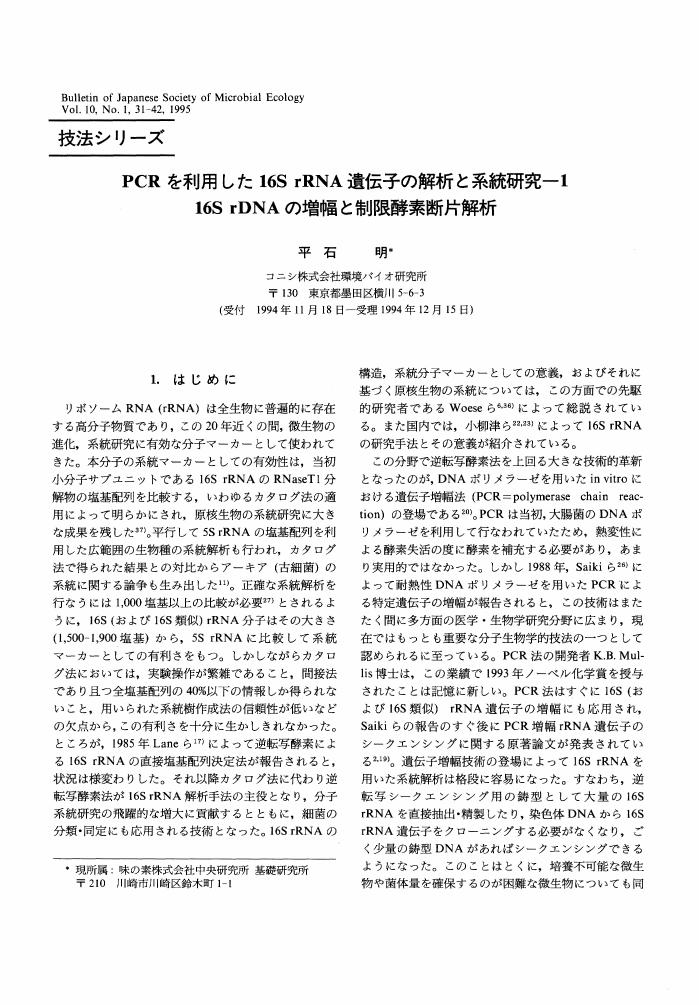4 0 0 0 OA 溶藻性微生物の種類と日本の湖沼,河川における分布
- 著者
- 山本 鎔子
- 出版者
- Japanese Society of Microbial Ecology / The Japanese Society of Soil Microbiology
- 雑誌
- Bulletin of Japanese Society of Microbial Ecology(日本微生物生態学会報) (ISSN:09117830)
- 巻号頁・発行日
- vol.2, no.2, pp.77-88, 1988-03-31 (Released:2009-10-05)
- 参考文献数
- 50
- 被引用文献数
- 3 6
Seasonal distribution patterns of agents which lyse cyanobacteria in lakes and rivers were studied. Higher numbers were detected in a warmer and more polluted. It is possile that cyanobacter development is controlled by these agents. The characteristics of various agents including protozoa, fungi, bacteria and viruses also were discussed.
2 0 0 0 OA Current Forum
- 出版者
- Japanese Society of Microbial Ecology / The Japanese Society of Soil Microbiology
- 雑誌
- Bulletin of Japanese Society of Microbial Ecology(日本微生物生態学会報) (ISSN:09117830)
- 巻号頁・発行日
- vol.10, no.3, pp.137-139, 1995-12-31 (Released:2009-10-05)
1 0 0 0 OA 化学独立栄養アンモニア酸化細菌
- 著者
- 高橋 令二 徳山 龍明
- 出版者
- Japanese Society of Microbial Ecology / The Japanese Society of Soil Microbiology
- 雑誌
- Bulletin of Japanese Society of Microbial Ecology(日本微生物生態学会報) (ISSN:09117830)
- 巻号頁・発行日
- vol.8, no.2, pp.95-107, 1993-10-31 (Released:2009-10-05)
- 参考文献数
- 56
- 被引用文献数
- 1
Ammonia and nitrite-oxidizing bacteria contribute to nitrification, a part of the nitrogen cycle in natural environments. These bacteria are important since they decompose accumulated inorganic nitrogen compounds and toxic substances such as nitrogen oxides and consume (fix) of CO2, a factor implicated in global warming. Nitrosomonas europaea, a chemoautotrophic ammonia-oxidizing bacterium which contributes to the first stage of nitrification has been studied in detail. It oxidizes ammonia as the sole nitrogen source of nitrite via hydroxylamine as an intermendiate. It grows under completely inorganic conditions using energy (65kcal) produced by the oxidation of ammonia and atmospheric CO2, its sole carbon source. Its growth rate is thus quite low and no extensive biochemical studies have been conducted. This paper reviews recent studies on the ammonia-oxidizing system (ammonia and hydroxylamine oxidation) in Nitrosomonas europaea. Data obtained with two strains of Nitrosomonas including a pure isolated strain of Nitrosomonas sp. TK794 are presented.
1 0 0 0 OA 化学合成独立栄養細菌における炭酸固定
- 著者
- 高橋 令二 徳山 龍明
- 出版者
- Japanese Society of Microbial Ecology / The Japanese Society of Soil Microbiology
- 雑誌
- Bulletin of Japanese Society of Microbial Ecology(日本微生物生態学会報) (ISSN:09117830)
- 巻号頁・発行日
- vol.9, no.3, pp.135-147, 1994-12-31 (Released:2009-10-05)
- 参考文献数
- 62
CO2 accumulation as a factor of global warming is requiring attention. Obligate chemoautotrophic bacteria grow independently of organic conditions with energy from the oxidation of reduced inorganic compounds and CO2 from the atmosphere as sole carbon sources. Chemoautotrophic bacteria consume (fix) CO2, and assimilate CO2 via the reductive pentose phosphate cycle (Calvin cycle). CO2 assimilation via the reductive tricarboxylic acid cycle (TCA cycle) occurs particularly in thermophilic hydrogen-oxidizing bacteria. This paper reviews studies on the tricarboxylic acid cycle in relation to CO2 fixation reactions of chemoautotrophic bacteria, especially nitrifying bacteria.Nitrifying bacteria promote nitrification, a stage in the nitrogen cycle. Ammonia-oxidizing bacteria (Nitrosomonas) oxidize ammonia as the sole nitrogen source of nitrite, and nitrite-oxidizing bacteria (Nitrobacter) oxidize nitrite as the sole nitrogen source of nitrate. Both bacteria fix CO2 mainly via the Calvin cycle in which ribulose 1, 5-bisphosphate carboxylase/oxygenase (RuBisCO) is a key enzyme. Less CO2 is assimilated by the phosphoenolpyruvate carboxylase pathway. The TCA cycle of nitrifying bacteria was studied and CO2 assimilation was clarified in greater detail.
1 0 0 0 OA セルゲイ・ニコラエヴィッチ・ヴィノグラドスキー(1856-1952)
- 著者
- ザヴァルジン ゲア 石本 真
- 出版者
- 日本微生物生態学会・日本土壌微生物学会
- 雑誌
- Bulletin of Japanese Society of Microbial Ecology(日本微生物生態学会報) (ISSN:09117830)
- 巻号頁・発行日
- vol.6, no.1, pp.45-54, 1991-05-01 (Released:2009-10-05)
- 参考文献数
- 6
1 0 0 0 OA PCRを利用した16S rRNA遺伝子の解析と系統研究-1
- 著者
- 平石 明
- 出版者
- 日本微生物生態学会・日本土壌微生物学会
- 雑誌
- Bulletin of Japanese Society of Microbial Ecology(日本微生物生態学会報) (ISSN:09117830)
- 巻号頁・発行日
- vol.10, no.1, pp.31-42, 1995-05-31 (Released:2009-10-05)
- 参考文献数
- 38
- 被引用文献数
- 9 7


